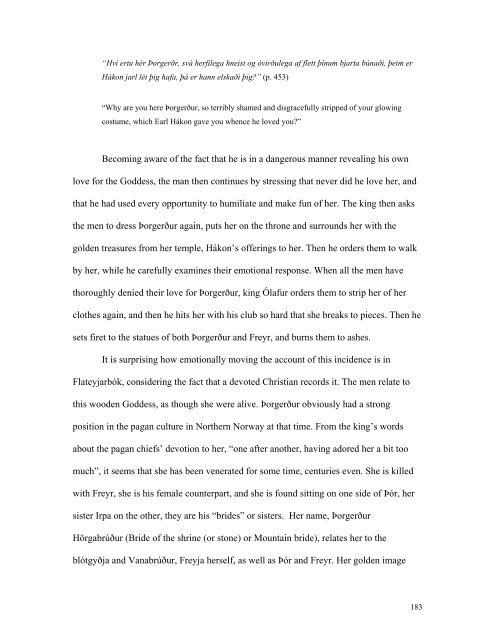Create successful ePaper yourself
Turn your PDF publications into a flip-book with our unique Google optimized e-Paper software.
“Hví ertu hér Þorgerðr, svá herfilega hneist og óvirðulega af flett þínum bjarta búnaði, þeim er<br />
Hákon jarl lét þig hafa, þá er hann elskaði þig?” (p. 453)<br />
“Why are you here Þorgerður, so terribly shamed <strong>and</strong> disgracefully stripped <strong>of</strong> your glowing<br />
costume, which Earl Hákon gave you whence he loved you?”<br />
Becoming aware <strong>of</strong> the fact that he is in a dangerous manner revealing his own<br />
love for the Goddess, the man then continues by stressing that never did he love her, <strong>and</strong><br />
that he had used every opportunity to humiliate <strong>and</strong> make fun <strong>of</strong> her. <strong>The</strong> king then asks<br />
the men to dress Þorgerður again, puts her on the throne <strong>and</strong> surrounds her with the<br />
golden treasures from her temple, Hákon’s <strong>of</strong>ferings to her. <strong>The</strong>n he orders them to walk<br />
by her, while he carefully examines their emotional response. When all the men have<br />
thoroughly denied their love for Þorgerður, king Ólafur orders them to strip her <strong>of</strong> her<br />
clothes again, <strong>and</strong> then he hits her with his club so hard that she breaks to pieces. <strong>The</strong>n he<br />
sets firet to the statues <strong>of</strong> both Þorgerður <strong>and</strong> Freyr, <strong>and</strong> burns them to ashes.<br />
It is surprising how emotionally moving the account <strong>of</strong> this incidence is in<br />
Flateyjarbók, considering the fact that a devoted Christian records it. <strong>The</strong> men relate to<br />
this wooden Goddess, as though she were alive. Þorgerður obviously had a strong<br />
position in the pagan culture in Northern Norway at that time. From the king’s words<br />
about the pagan chiefs’ devotion to her, “one after another, having adored her a bit too<br />
much”, it seems that she has been venerated for some time, centuries even. She is killed<br />
with Freyr, she is his female counterpart, <strong>and</strong> she is found sitting on one side <strong>of</strong> Þór, her<br />
sister Irpa on the other, they are his “brides” or sisters. Her name, Þorgerður<br />
Hörgabrúður (Bride <strong>of</strong> the shrine (or stone) or Mountain bride), relates her to the<br />
blótgyðja <strong>and</strong> Vanabrúður, Freyja herself, as well as Þór <strong>and</strong> Freyr. Her golden image<br />
183


